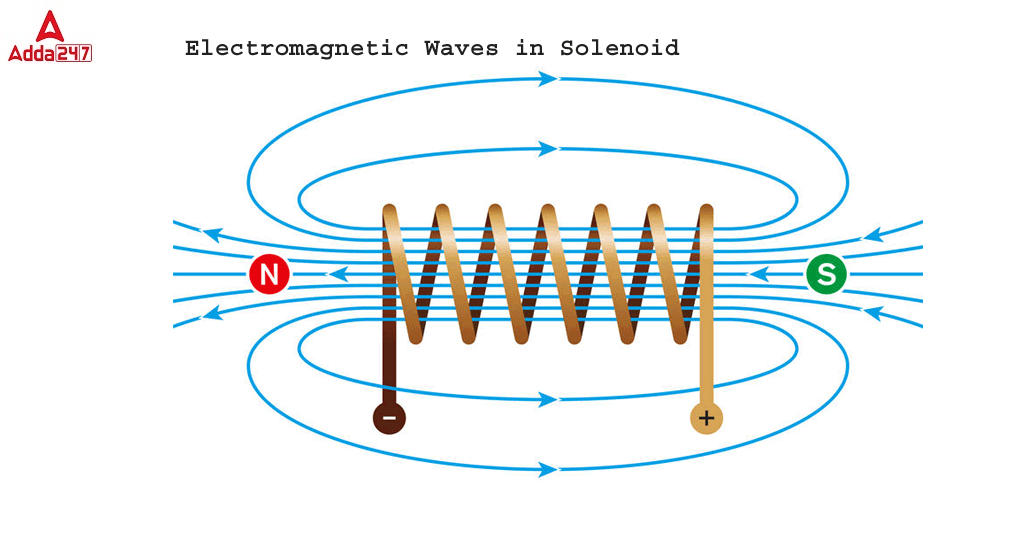Table of Contents
What is a Solenoid? for Class 10
Solenoids are basically coils of wire. These generate a magnetic field which strives a force over a metallic element. This happens when we apply the electric current to the solenoid.
Solenoids help the energy to convert into action instantly. Therefore, these work decently for those applications which require immediate action.
What is a Solenoid in Physics?
A solenoid is a basic term for a coil of wire that we use as an electromagnet. We also refer to the device that can convert electrical energy into mechanical energy as a solenoid.
Actually it generates a magnetic field for creating linear motion from the electric current. With the use of a magnetic field. Basic applications of the solenoids are to be used in switches for power. Like the starter in any vehicle. A valve in a sprinkler system is also an example.
This may look very much similar to that of a bar magnet. If a soft iron rod is kept inside the solenoid, it will behave like an electromagnet. The electromagnet will be a temporary magnet which is formed only when current is passing through it. Generally the soft iron metal is being
used as the core in the solenoid in order to create the strong magnetism.
Class 10 students can now join the board exam preparation batch by Adda247 and ace their board exam.
What is a Solenoid and How does it work?
As discussed above a solenoid is a coil of wire. It is in the shape of a corkscrew and wraps around a piston. On the other hand, it is made up of iron. Likely in all the electromagnets. When an electric current passes through the wire, a magnetic field is generated.
More importantly, electromagnets are better as compared to permanent magnets because they can be switched on and off by the removal of the electric current or by the application.
This makes them more useful like switches and valves and also allows them to be automated entirely. Likewise, all other magnets and activated solenoid’s magnetic field have both positive and negative poles that result in attracting or repelling material sensitive to magnets.
What is a Solenoid coil?
The starter solenoid in an automobile ignition system acts as a relay. This brings the metal contacts to a place that results in closing a circuit. When the motorcar’s ignition activates, the starter solenoid receives a small electric current, basically by the turn of the key.
Then the solenoid’s magnetic field pulls on the contact, and this process closes the circuit between the starter motor and the car’s battery. In order to maintain the circuit, the starter solenoid needs a constant flow of electricity. When the engine starts then the solenoids are not most active because the engine is self-powering.
What is a Solenoid Coil, Valve, and Lock?
Solenoids are extremely useful and incredibly versatile. We can find them almost everywhere from doorbells to paintball guns and even in automated factory equipment. In the doorbell, the audible sound is generated because the metal piston strikes at a tone bar.
The magnetic field of solenoids is the force that moves the piston and this force receives the electric current when we ring the doorbell.
As the electric current passes through the solenoid’s coils, the creation of a magnetic field takes place. The magnitude’s strength is measured by the number of coils featured by the solenoid.
The armature in a solenoid is movable: therefore, a voltage passes through the coils and the armature increases the flux linkage by its movement.
This happens due to the closing of the air gap between the two cores which are movable or the armature. They come with the spring so that the voltage is switched off to the solenoid, and then it gets back to its initial position.
Solenoid Most Important Questions | Term 2 | Class 10 Science | Magnetic Effects of Electric Current
What is a Solenoid used for?
The solenoids are useful in many applications, from appliances to electron hobbies. They are usually found in the applications that require a feature that can automatically turn the appliance on or off. For example, an electric torch or an engine kill switch commonly used in motorbikes nowadays.
What is a Solenoid Class 10- FAQs
Question 1 What is a solenoid short answer?
Ans. A solenoid is a coil of insulated or enameled wire wound on a rod-shaped form made of solid iron, solid steel, or powdered iron. Devices of this kind can be used as electromagnets, as inductors in electronic circuits, and as miniature wireless receiving antennas.
Question 2 What is solenoid and its uses in class 10?
Ans. A solenoid is a basic term for a coil of wire that we use as an electromagnet. We also refer to the device that can convert electrical energy into mechanical energy as a solenoid. Actually it generates a magnetic field for creating linear motion from the electric current. With the use of a magnetic field.
Question 3 What is the difference between solenoid and electromagnet?
Ans. The main difference between solenoid and electromagnet is that solenoid is the name given to a long and narrow helical loop of wire, whereas an electromagnet is a magnet whose magnetic properties depend on an electric current. Most often, electromagnets are constructed using solenoids
Question 4 Who invented the solenoid?
Ans. André-Marie Ampere
Question 5 What is the solenoid made of?
Ans. A solenoid is a cylindrical coil of wire acting as a magnet when carrying electric current. Q. A long solenoid is fabricated by closely winding a wire of radius 0.5 mm over a cylindrical nonmagnetic frame so that the successive turns nearly touch each other.



 JEE Main Rank Wise Colleges List 2025, C...
JEE Main Rank Wise Colleges List 2025, C...
 UK, UP, MP, CBSE Board Result 2025 Live ...
UK, UP, MP, CBSE Board Result 2025 Live ...
 CUET UG Exam Date Sheet 2025 @cuet.nta.n...
CUET UG Exam Date Sheet 2025 @cuet.nta.n...

